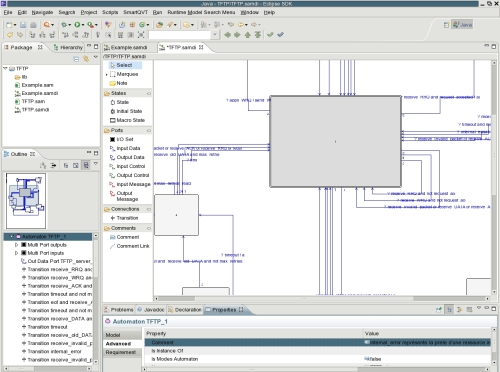| Organisation: |
INRIA Grenoble - Rhône-Alpes / VASY
and
Airbus (FRANCE)
|
| Method: |
SAM
LNT
Temporal logic
|
| Tools used: |
CADP (Construction and Analysis of Distributed Processes)
|
| Domain: |
Embedded Systems for Avionics.
|
| Period: |
2008-2009
|
| Size: |
1,200 lines of LNT, 29 temporal logic formulas
1.5 billion states and 6.8 billion transitions
|
| Description: |
In the context of the TOPCASED project, the VASY team studied how CADP
can be used to verify avionics protocols written in SAM, a graphical
synchronous language developed by Airbus. The first step was to equip
SAM with a formal semantics that did not exist so far. In collaboration
with Airbus, the SAM subset actually used was identified. Three
simplifications of SAM diagrams (elimination of multi-ports,
subsystems, and macro-states) were done and a formal semantics of the
resulting fragment was defined.
Airbus provided a case-study for analysis using CADP, namely a
ground/plane communication protocol based on TFTP (Trivial File
Transfer Protocol), which operates above the standard UDP (User
Datagram Protocol) layer. This protocol was specified as a SAM
automaton having 7 states and 39 transitions. To verify this protocol
using CADP, a translation from SAM into LNT data types and
functions was proposed. Basically, a SAM automaton is translated into
a Mealy function that takes the current state and a list of input
values, and produces the next state and a list of output values.
Following this approach, a LNT version of the TFTP automaton was
obtained.
Then, a LNT model of an entire system was produced, in which two
synchronous TFTP automata execute asynchronously and communicate with
each other using UDP links. This is a typical example of a GALS
(Globally Asynchronous, Locally Synchronous) system. The
unreliability of UDP (which may lose, duplicate and/or reorder
messages) was specified by designing various LNT models of UDP
based on bounded FIFO queues and bag data structures. The LNT
specification of the entire system was translated into LOTOS using
the LNT2LOTOS translator.
A set of 29 correctness properties were formulated in temporal logic
and verified on the generated LOTOS model using the EVALUATOR 3.5 and
4.0 model checkers of CADP. This enabled to find 19 errors; many of
these errors, even if not critical, were degrading the protocol
performance (due to, e.g., useless packet retransmissions). The impact
of these errors was quantified by using the EXECUTOR tool of CADP to
simulate the LOTOS model. This allowed to estimate, for each error,
its individual impact on the performance. The approach was further
enhanced in several respects: the LNT code was optimized to reduce
the generated state spaces; SVL scripts were developed to automate the
various analysis operations; and model checking was enhanced by hiding,
in the state spaces, all labels that are not relevant for a given
temporal logic formula.

SAM model of the TFTP in a TOPCASED editor
|
| Conclusions: |
A simple and elegant approach was proposed for modelling and analysing
systems consisting of synchronous components interacting
asynchronously, commonly referred to as GALS in the hardware design
community. Contrary to other approaches that stretch or extend the
synchronous paradigm to model asynchrony, the approach proposed
preserves the genuine semantics of synchronous languages, as well as
the well-known semantics of asynchronous process calculi. It allows to
reuse without any modification the existing compilers for synchronous
languages, together with the existing compilers and verification tools
for process calculi.
The feasibility of the approach was demonstrated on an industrial case
study, the TFTP/UDP protocol for which model checking and performance
evaluation were successfully performed using the TOPCASED and CADP
software tools. Although this case study was based on the SAM
synchronous language and the LOTOS/LNT process calculi, the
approach seems general enough to be applicable to any synchronous
language whose compiler can translate (sets of) synchronous components
into Mealy machines - which is almost always the case - and to any
process calculus equipped with asynchronous concurrency and
user-defined functions.
|
| Publications: |
[Garavel-Thivolle-09]
Hubert Garavel and Damien Thivolle.
"Verification of GALS Systems by Combining Synchronous Languages and
Process Calculi". Proceedings of the 16th International SPIN Workshop
on Model Checking of Software SPIN'2009, Lecture Notes in Computer
Science vol. 5578, pages 241-260. Springer Verlag, June 2009.
Available on-line from
http://cadp.inria.fr/publications/Garavel-Thivolle-09.html
|
| Contact: |
Hubert Garavel
INRIA Grenoble - Rhône-Alpes / VASY project-team
655, avenue de l'Europe
F-38330 Montbonnot Saint Martin
FRANCE
Tel: +33 (0)4 76 61 52 24
Fax: +33 (0)4 76 61 52 52
Email: Hubert.Garavel@inria.fr
|
| Further remarks: |
This case study, amongst others, is described on the CADP Web site:
http://cadp.inria.fr/case-studies
|


 Back to the CADP case studies page
Back to the CADP case studies page